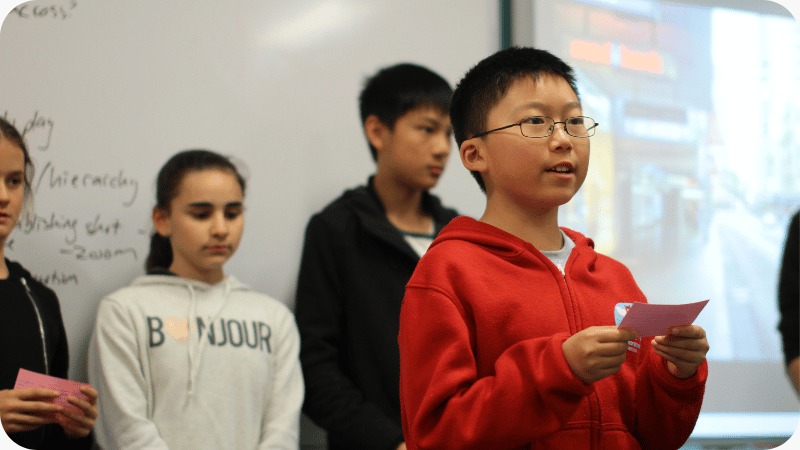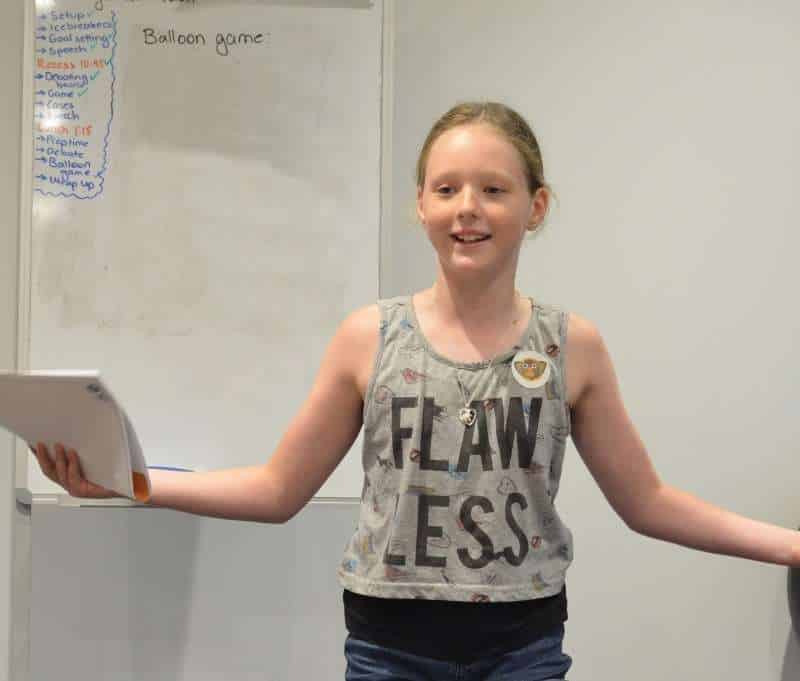How to Start a Speech for Kids
27 July 2022
Have you felt nervous when you have given speeches?
Don’t worry, you’re not alone. Many people feel anxious when they have to speak in front of an audience. But don’t let your nerves get the best of you. By following a few simple tips, you can develop your communication skills and deliver a well-crafted speech that will engage and excite your listeners – an incredibly important life skill.
Introductions are Key
When you’re giving a speech, the introduction is key.
How a person starts their speech is important because it’s what grabs the attention of the audience and gets them interested in what they have to say. It’s their opportunity to make a good first impression, so you want to make sure that it’s strong and engaging. This is especially true for children, who given their age often lack the gravitas that is more easily attributed to many adults.
A well-crafted introduction can set the tone for a child’s entire speech, so it’s worth taking the time to get it right. In addition, a good introduction will help keep a child’s audience focused on what they have to say. So if your child is feeling stuck on how to start their next speech, be sure to get them to think hard about their introduction, both in terms of the words they’re going to use and the manner in which they want to present it. With a little practice, they will be able to craft an intro that leaves a lasting impression on their audience!
In this blog we’re going to explore five ways a child might want to start their speech, as well as a range of other public speaking tips to help kids get the most out of their speeches:
- How to use a personal anecdote to engage your listeners
- The best way to use rhetoric to hook your audience
- Whether bold statements, startling statistics, or famous quotes add up to a good speech introduction
- How keeping it simple, following a structure, and building up confidence can help children prepare a killer intro
If you or your child wants to learn more about introductions or other public speaking tips for everything from body language to visual aids, check out our YouTube channel for plenty of ideas on how to help your child prepare their next speech!

Starting with a personal story to engage your audience members
One way a child can easily engage their audience members from the start is to share a personal anecdote relevant to their topic. This can help listeners connect with the child on a personal level and make them more interested in what they have to say.
For example, if your child was giving a speech about the importance of education, they could share a story about a time they struggled when they were younger and how working hard helped them turn things around. Or, if they were speaking to other students about the importance of being kind to others, they could share an anecdote about a time when someone was kind to them and how this made them feel.
By sharing a personal story, any child can help their audience see them as a real person and not just some abstract figure who is talking at them. As a result, they will be more likely to engage with what the speaker is saying and remember it long after the speech is over.

Using rhetoric to your to grab your audience’s attention
Another effective opening a child can use to open their speech is to pose a rhetorical question to their audience. This will get listeners thinking about the answer to their question and make them eager to hear what they have to say next.
This is an especially effective way to open speeches, as it helps to set the stage for what you’ll be discussing in a way that piques the interest of your audience. People (and especially kids) are naturally curious – if you’ve got an interesting take on the question, or chose to start your speech with a question the audience is interested in but don’t know the answer to, you’re much more likely to hook them in and leave them keen for what comes next.
For example, if a child was introducing a speech on public speaking, they could ask the audience “How many of you have ever had to give a speech in front of a large group of people?” This question will get people engaged and thinking about their own experiences with public speaking.
It is important to remember that an opening line will only be effective if the speaker pauses, looks up from their palm cards and make eye contact with their audience – this gives them time to consider what the speaker has said and relate to the key points they hoped the audience would take away. It is important to keep this in mind whenever you practice your speech as well!

Bold statements, statistics and quotes
There are plenty of other ways that you might want to open your speech, and whilst these may work for some kids, you should be wary that they’re used properly.
Bold Statements…
One way might be to make a bold statement about your topic in your introduction, potentially explaining an extraordinary scenario to your listeners. This can help listeners understand the main point of your speech and get them interested in hearing more.
…Startling Statistics…
Another could be to start with a startling statistic or fact related to your topic. This can immediately grab the attention of your listeners and set the stage for the rest of your speech.
…and Famous Quotes…
The final way children might be able to open a speech is by referencing a famous quote that is relevant to their topic. This will show that you are knowledgeable about the subject and will get listeners thinking about the implications of the quote in relation to your topic.
…often aren’t the most exciting openers
That said, for most people all three of these are generally less effective than personal anecdotes or rhetorical questions. If you’re going to go down this route, make sure that your statement is truly bold, your statistic is interesting and relevant, or your quote is well-chosen. Otherwise, the message you’re trying to convey can easily be lost, and your introduction can become substantially less impactful.

Public speaking tips to improve my child’s speech introduction
Whilst an introduction isn’t your whole speech, it is one of the most essential parts of crafting an engaging presentation. Below are some tips for helping your child develop a great speech.
Keep the Message Simple
Firstly, when writing the body of the presentation, make sure to focus on a single idea (rather than a range of possible topics) and keep the message simple – rather than attempting to conquer the world, a strong speech will usually focus on a core thesis, with a key point (including up to three of these can work well) to back it up. It is important to write speeches with this in mind, as it allows public speakers to prepare a concise and easy-to-follow introduction, helping their audience focus on what’s important.
Looking for ideas on how to pick the right message? Check out our blogs on picking the perfect speech topic and 101 incredible public speaking topics to see how to use your passion to make your next presentation even more engaging!
Follow a Coherent Structure
Secondly, make sure that the introduction follows a coherent structure that feels comfortable. Start with one of the hooks we discussed above – it’s important that your child’s speech grabs the audience’s attention. Move on from here to actually address the audience – whether this be a “good morning” or a simple “hi there” – and introduce the key subject you’ll be speaking about. Finally, an introduction will usually flag the ‘matter’ of your speech – the main arguments you’re going to speak about. Using a structure like this can help kids feel more comfortable and aid them in keeping on message when they present.
Interested in learning more about how to structure a presentation? Have a look at our blog on how to structure a speech to learn more!
Build Up Confidence in Advance
Finally, make sure to build up your child’s confidence in advance. This is something that many children have difficulty with – once they have written their speech, make sure that:
- you talk to them about what they wanted to achieve with their speech, help them find the best words to do so, and answer any questions they might have;
- the speech has been written as dot points on palm cards, so they can practice properly and aren’t able to read the speech word for word;
- if your child is nervous, you speak with them about how they can use deep breaths before they talk to help dispel the nerves and ensure they are able to stay on message;
- if they’re up to it, you look at the presentation skills your child is using, and match things like gestures and facial expressions to the words they’re using, ensuring they are getting their point across in the most persuasive way possible – practice makes perfect; and
- they practice, practice, and practice again: you will want to give them lots of opportunities to deliver their speech, whether it be to friends, family members, or other adults – the idea is to not only practice their speech, but also to ensure it sticks to the time limit and provide feedback to your child, and to reinforce that it is an engaging speech, as this will give them to confidence to deliver an even better presentation when they stand in front of a proper room.
The more confident children feel about their speech, the more comfortable they will feel when they stand in front of their audience and start speaking. Every child must find their voice before they enter the room to ensure they’re ready to begin as soon as they step in front of their audience. This starts with family at home, and over time can build up to larger groups and have wide-reaching implications for any child’s life.

Want to learn more about the benefits of developing public speaking and debating skills? Check out our blog to find out how your child could benefit!
The key ideas for how to start a speech for kids
When it comes to giving a speech (and public speaking more generally), you need to grab the attention of your audience and give them a taste of what’s to come.
But how can children make sure their introductions are up to scratch?
The main things to remember are:
- Hook the audience with a catchy opening like an anecdote or rhetorical question
- Make sure the speech (and introduction) focuses on one central message
- Have a clear structure
- Practice your introduction multiple times
- Build up confidence in advance
It’s important to give your child the best chance for success when it comes to public speaking and developing communication skills. This means teaching them how to write and deliver a good introduction. By following these simple tips, you can help them make a great first impression that will get their audience hooked.
If you’re looking for more advice on this topic or want to help your child build up their confidence in advance, check out some of our other blogs, head to our YouTube, or enrol them in one of our public speaking or debating courses today. We’ll provide everything they need to nail their next speech!



